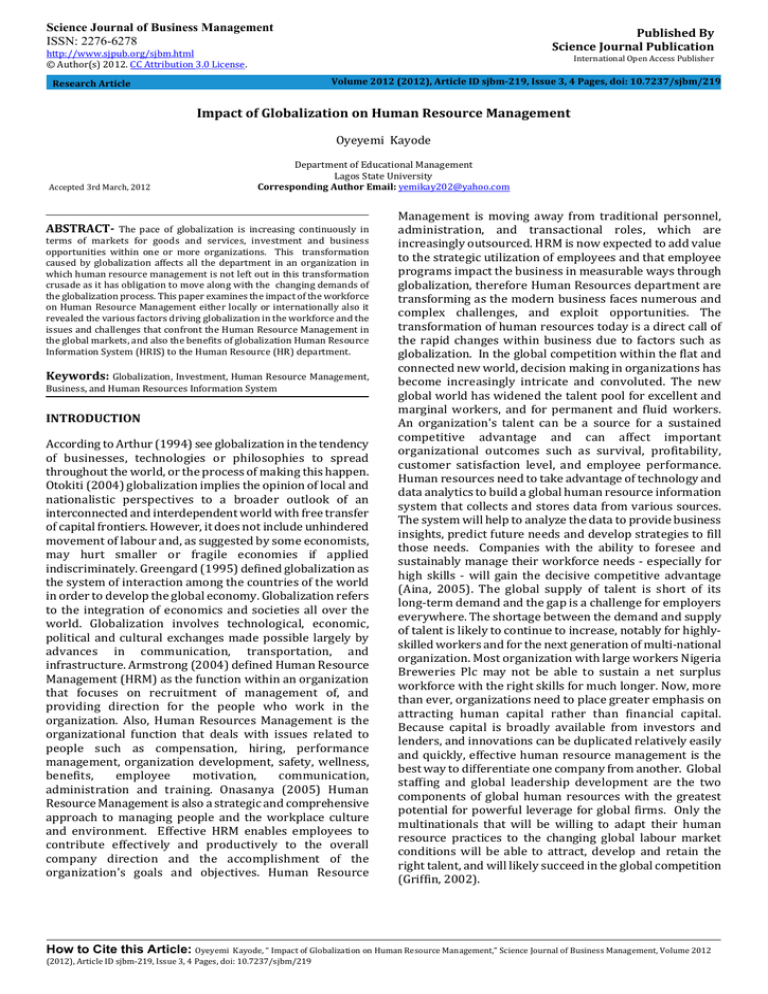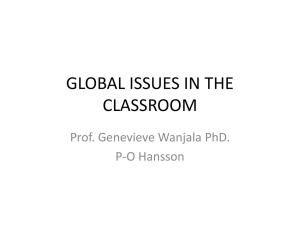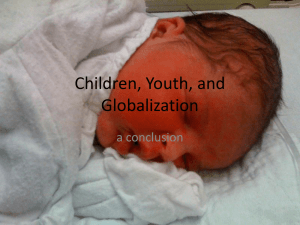Impact of Globalization on Human Resource Management
advertisement

Science Journal of Business Management ISSN: 2276-6278 Published By Science Journal Publication http://www.sjpub.org/sjbm.html © Author(s) 2012. CC Attribution 3.0 License. International Open Access Publisher Volume 2012 (2012), Article ID sjbm-219, Issue 3, 4 Pages, doi: 10.7237/sjbm/219 Research Article Impact of Globalization on Human Resource Management Oyeyemi Kayode Accepted 3rd March, 2012 Department of Educational Management Lagos State University Corresponding Author Email: yemikay202@yahoo.com ABSTRACT- The pace of globalization is increasing continuously in terms of markets for goods and services, investment and business opportunities within one or more organizations. This transformation caused by globalization affects all the department in an organization in which human resource management is not left out in this transformation crusade as it has obligation to move along with the changing demands of the globalization process. This paper examines the impact of the workforce on Human Resource Management either locally or internationally also it revealed the various factors driving globalization in the workforce and the issues and challenges that confront the Human Resource Management in the global markets, and also the benefits of globalization Human Resource Information System (HRIS) to the Human Resource (HR) department. Keywords: Globalization, Investment, Human Resource Management, Business, and Human Resources Information System INTRODUCTION According to Arthur (1994) see globalization in the tendency of businesses, technologies or philosophies to spread throughout the world, or the process of making this happen. Otokiti (2004) globalization implies the opinion of local and nationalistic perspectives to a broader outlook of an interconnected and interdependent world with free transfer of capital frontiers. However, it does not include unhindered movement of labour and, as suggested by some economists, may hurt smaller or fragile economies if applied indiscriminately. Greengard (1995) defined globalization as the system of interaction among the countries of the world in order to develop the global economy. Globalization refers to the integration of economics and societies all over the world. Globalization involves technological, economic, political and cultural exchanges made possible largely by advances in communication, transportation, and infrastructure. Armstrong (2004) defined Human Resource Management (HRM) as the function within an organization that focuses on recruitment of management of, and providing direction for the people who work in the organization. Also, Human Resources Management is the organizational function that deals with issues related to people such as compensation, hiring, performance management, organization development, safety, wellness, benefits, employee motivation, communication, administration and training. Onasanya (2005) Human Resource Management is also a strategic and comprehensive approach to managing people and the workplace culture and environment. Effective HRM enables employees to contribute effectively and productively to the overall company direction and the accomplishment of the organization's goals and objectives. Human Resource How to Cite this Article: Oyeyemi Management is moving away from traditional personnel, administration, and transactional roles, which are increasingly outsourced. HRM is now expected to add value to the strategic utilization of employees and that employee programs impact the business in measurable ways through globalization, therefore Human Resources department are transforming as the modern business faces numerous and complex challenges, and exploit opportunities. The transformation of human resources today is a direct call of the rapid changes within business due to factors such as globalization. In the global competition within the flat and connected new world, decision making in organizations has become increasingly intricate and convoluted. The new global world has widened the talent pool for excellent and marginal workers, and for permanent and fluid workers. An organization's talent can be a source for a sustained competitive advantage and can affect important organizational outcomes such as survival, profitability, customer satisfaction level, and employee performance. Human resources need to take advantage of technology and data analytics to build a global human resource information system that collects and stores data from various sources. The system will help to analyze the data to provide business insights, predict future needs and develop strategies to fill those needs. Companies with the ability to foresee and sustainably manage their workforce needs - especially for high skills - will gain the decisive competitive advantage (Aina, 2005). The global supply of talent is short of its long-term demand and the gap is a challenge for employers everywhere. The shortage between the demand and supply of talent is likely to continue to increase, notably for highlyskilled workers and for the next generation of multi-national organization. Most organization with large workers Nigeria Breweries Plc may not be able to sustain a net surplus workforce with the right skills for much longer. Now, more than ever, organizations need to place greater emphasis on attracting human capital rather than financial capital. Because capital is broadly available from investors and lenders, and innovations can be duplicated relatively easily and quickly, effective human resource management is the best way to differentiate one company from another. Global staffing and global leadership development are the two components of global human resources with the greatest potential for powerful leverage for global firms. Only the multinationals that will be willing to adapt their human resource practices to the changing global labour market conditions will be able to attract, develop and retain the right talent, and will likely succeed in the global competition (Griffin, 2002). Kayode, “ Impact of Globalization on Human Resource Management,” Science Journal of Business Management, Volume 2012 (2012), Article ID sjbm-219, Issue 3, 4 Pages, doi: 10.7237/sjbm/219 Page 2 Science Journals Publication(ISSN:2276-6286) Factors Driving Globalization The last two decades have seen the evolution of the global manufacturing environment, majority of the manufacturers have global presence through exports, strategic alliances, joint ventures or as a part of a committed strategy to sell and produce in foreign markets (Greengard, 2005). Global Market Forces Global Cost Forces Globalization Process Technological forces Political and Macroeconomic Forces Fig 1: Conceptual Framework: The four driving forces of the Globalization Process. Adapted from global operators and logistics: (Philippe-Pure et. al, 2005). (a) Global Market forces (c) Global Cost Forces There is tremendous growth potential in the global markets which resulted in intensified foreign competition in local markets which forces the small-and-medium-sized companies to upgrade their operations and even consider expanding internationally. There has also been growth in demand which necessitates the development of a global network of manufacturing bases and markets when the markets are global, the production - planning task of the manager becomes difficult on one hand and allows more efficient utilization of resources on the others. New competitive priorities in manufacturing industries, that is product and process conformance quality, delivery reliability and speed, customization and responsiveness to customers, have forced companies to reprioritize the cost factors that drive their global operations strategies. The Total Quality Management (TQM) revolution brought with it a focus on total quality costs, rather than just direct labour cost companies realized that early activities such as product design and worker training substantially impact production costs. They began to emphasize prevention rather than inspection. In addition, they quantified the cost of poor design, low input quality and poor workmanship by calculating internal and external failure costs. All these realizations placed access to skilled workers and quality suppliers high on the priority list for firms competing on quality. Similarly, Just-in-Time (JIT) manufacturing methods, which companies widely adopted for the management of mass production systems, emphasized the importance of frequent deliveries by nearly supplies. A number of hightechnology industries have experienced dramatic growth in the capital intensity of production facilities. (b) Technological Forces A peculiar trend which was prevalent in the last decade, besides globalization, was a limited number of producers which emerged due to diversity among products and uniformity across national markets. Product diversity has increased as products have grown more complex and differentiated and product life cycles have shortened. These have been diffusion of technological knowledge and global low-cost manufacturing locations have emerged. In response to this diffusion of technological capability, multinational firms need to improve their ability to tap multiple sources of technology located in various countries. They also must be able to absorb quickly and commercialize effectively, new technologies that, in many, cases, were invented outside the firm thus overcoming the destructive and pervasive 'not - invented-here attitude and resulting inertia. How to Cite this Article: Oyeyemi (d) Political and Macroeconomic Forces Getting hit with unexpected or unreasonable currency devaluations in the foreign countries in which they operate is a nightmare for global operations managers. Managing exposure to changes in normal and real exchange rates is a task which the Kayode, “ Impact of Globalization on Human Resource Management,” Science Journal of Business Management, Volume 2012 (2012), Article ID sjbm-219, Issue 3, 4 Pages, doi: 10.7237/sjbm/219 Science Journals Publication(ISSN:2276-6286) Page 3 global operations manager must master. If the economics are favourable, the firm may even go so far as to establish a supplier in a foreign country where one does not yet exist. For example, if the local currency is chronically undervalued, it is to the firm's advantage to shift most of its sourcing to local vendors. has to look for opportunities to move different processes around the Globe. Human Resource Management issues and challenges in Global Market Human Resource Management A global Human Resource Information System can put vast amount of multinational employee data to strategic use. Ideally, the global database is automatically updated by the local databases ensuring data is not only inputted correctly, but only once. By applying consistent standards for data management, global HRIS reporting becomes more accurate and streamlined as all of the decision makers receive and have access to the same information. This information can then be used for in-depth analyzes to help HR and the organization make better, more informed decisions (Kane, 2001). By applying a consistent process for capturing and maintaining employee specific data (job, position and qualifications), the global HRIS can be used to identity, plan and budget for employee training, succession planning and expatriate assignments. As the "war on talent" continues to loom, a multinational organization with a global HRIS can very quickly and easily discover the right person to fill a specific position. Having the ability to locate the best qualified employee regardless of his/her location is a competitive advantage. Additionally, designing the system to identify with employees are interested in overseas assignments will also make the expensive and timeconsuming expatriate process quicker and easier (Miller, 2004). Using the Human Resource Information System (HRIS) to think locally, but compensate globally - compensation can be applied fairly across the globe while still being aware of and understanding differences in compensation for similar jobs in various countries. Compensation users are able to review plans in local and additional currencies and languages. A global HRIS can also provide compensation guidelines and help documentation either on or off-line to assist employees in understanding their compensation package and to assist the manager with award decisions and policies (Vernon, 2006). From the view of Greengard (2005) incorporating a global HRIS provides each manager with the capability to toggle a compensation model from the direct reports screen and complete planning for each of their direct or indirect reports. The HRIS is then able to immediately show the impact on local and global budgets and expenditures. From a qualitative perspective, the organization is able to quickly assess current employee availability and their qualifications for staffing the new department or project regardless of the employee's location. Overall, planning becomes more accurate and decisions become more transparent (Vernon, 2006). But, the benefits of a global Human Resource Information System (HRIS) go beyond the ability to analyze and use employee data. The system encourages geographically diverse operations to share ideas and innovations (Miller, 2004). It can also create an element of cultural cohesion and closeness for employees - especially those within the expatriate community (Insight consulting partners, 2004). Employees across the organization regardless of location, will feel more connected to each other and will have a single point of contact. (HRM) challenges to business especially those operating across the national boundaries as multinational or global enterprise competing in global markets entails many factors and centralization of its human resource practices is certainly vital to improve global competitiveness and empower employees for global assignment. To achieve success in global market place, the challenge of all businesses regardless of their size is to understand global corporate cultural differences and invest in human resources. There are certain. Vernon (2004) human resource management issues that are particular for the global enterprise. The key issues involve staffing policies selecting and retaining talented employee, training and development whilst encouraging employees to be innovative and creative, culture barriers, and legal frame work. Others issues include understanding the challenges of living and working conditions, performance appraisals from a distance, training and management development, compensation packages and labour relations and organized labour laws. Roles and Responsibilities of Human Resource Human resource is a department which leads the development and upgrade of the corporate culture. The common corporate culture is crucial for the global organization. The organization cannot act the same way around the globe when the corporate culture is different. On the other hand, the development of the common corporate culture is difficult. The nations are different. The HR role is to set up the international team, which develops the unified corporate culture and corporate values. The role of Human Resources is setting the essential training courses for managers. HR has to push managers to apply for the courses. They have to understand roots of the common corporate culture and how they are expected to behave globally. The employees and managers have to communicate globally with colleagues around the Globe. The unified way of communication, the approach to problem solving and identification with the organization make global decisions easier (CIPD , 2006). Human Resources should be the first global function. It has to introduce the globally managed, HR processes focused on the development of the global talents and bringing the unified approach. The performance management and the talent management are usually the first globally managed HR processes. The unified and globally managed performance management process helps to manage the performance of individual businesses in countries and helps to identify the future global leaders for the organization. The global Human Resources is able to identify best talents in the organization, and more talents of different countries. It is not easy to introduce the global mobility, but the global organization needs global managers, who are able to run different projects over continents. The identification of global leaders needs a strong global Human Resources. The HR professionals have to be trained in global policies, and they have to be managed from different centers of excellence around the Globe. The globalization demands new skills and competencies. Managers have to think globally, and they have to find advantages for the organization on the global basis. They have to be able to negotiate with partners from different cultural background. Human Resources has to adopt its processes, procedures, policies and training to ease the life of managers into the global world of the organization. The role of Human Resources is to help the organization to become the real global organization. Human resources has to identify leaders, it How to Cite this Article: Oyeyemi Benefits of Global Human Resources Information System to the Human Resource Management Conclusion The increasing prevalence of globalization is driven by a number of factors, including shortage of talent in developing countries, global market forces, technological forces, global cost forces. Also, this paper examines the various issues in Human Resources Management and challenges in the global market also this paper look into the roles and responsibilities of Human Resources in this globalization era, and finally examines the benefits of global HIRS to the growth and development of HRM in an organization. Kayode, “ Impact of Globalization on Human Resource Management,” Science Journal of Business Management, Volume 2012 (2012), Article ID sjbm-219, Issue 3, 4 Pages, doi: 10.7237/sjbm/219 Page 4 Science Journals Publication(ISSN:2276-6286) Reference 1. Aina Sola (2005). Managing The Human Capital in Nigeria, Fountain Training Consult, Ikeja. 2. Armstrong, M. (2004). A Handbook of Human Resource Management Practice, 9th Edition, South Asian Published. 3. Arthur, J. B. (1994). "Effects of Human Resource System on Manufacturing Performance and Turnover". Academy of Management Journal. 4. Chartered Institute of Personnel and Development - CIPD (2006). HR and Technology. http://www.ciped.co.uk. 5. Greengard, S. (1995). "When HRMs Goes Global: Managing the Data Highway". Personnel Journal 76(6), 90-106. 6. Greengard, S. (2005). Putting it All Together Workforce Management. 83(11): 6-10. 7. Griffin, Ricky W. (2002). Management. (7th Edition). Hougliton Milfflin Company 8. Insight Consulting Partner (2004). Going Global with your HIRS. http://www.insightcp.com/res-17htm. 9. Kane, B. (2001). "HRM and Trends in Management: Travelling a Well-worn Path? New Zealand: Auckland. 10. Miller, M. S. (2004). Establishing Value for HR Technology. The Conference Board. 11. Onasanya, S. A. (2005). Effective Personnel Management and Industrial Relations (revised Edition) CMD, Management Village. 12. Otokiti, S. O. (2004). International Business (1st Edition) Pumark Nigeria Limited, Lagos. 13. Vernon, P. (2004). Delivering on the Promise of HR Transformation. http://www.mercerhr.com. How to Cite this Article: Oyeyemi Kayode, “ Impact of Globalization on Human Resource Management,” Science Journal of Business Management, Volume 2012 (2012), Article ID sjbm-219, Issue 3, 4 Pages, doi: 10.7237/sjbm/219




